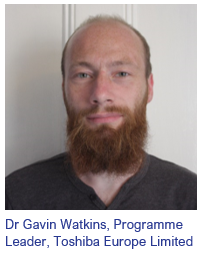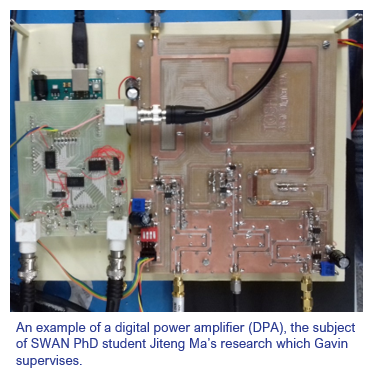As a partnership project, SWAN’s research programme is enriched by the knowledge and expertise of our industrial partners. In the next blog in our spotlight series, we spoke to Dr Gavin Watkins, Programme Leader at Toshiba Europe Limited, about his contributions to the SWAN project, taking a close look at some of the benefits that come from collaboration between academia and industry.
Can you tell us a little bit about your own research interests and background?
I first became interested in electronics at maybe six or seven years old. That grew into a fascination with radios when I reached my teens which pretty much cemented my career as a radio frequency (RF) engineer focusing on power amplifiers (PA). I have been with Toshiba now for 13 years still working with RF PA, but also in a wide range of other topics including radar, power electronics and full duplex communications. Electronics has always fascinated me and probably will for the rest of my life.
How does the SWAN programme of work fit into both your own and your company’s research priorities?
As part of my role at Toshiba I develop new and novel RF PAs. These are essentially the bit in a transmitter (i.e., inside your mobile phone) which provides the signal for the antenna. They are generally responsible for the largest portion of a transmitter’s power consumption. Reducing their power consumption – increasing efficiency – has in one way or another been my career for almost 20 years now. This is important to Toshiba as a manufacturer of television transmitters where an increased efficiency leads to a saving in power consumption for broadcasters.
Can you give us a brief overview of the work packages you have been involved with so far as part of the SWAN project?
I am mainly involved with Work Package 4, which focuses on the RF receiver and transmitter hardware. Largely this takes the form of taking on the role of industrial supervisor for PhD student Jiteng Ma, and providing direction for the general project. Jiteng’s research is into digital PAs, a new PA architecture which is inherently agile by its digital nature making it well suited for the objectives of the SWAN project.
 Where does this work fit in with SWAN’s wider Research Challenges?
Where does this work fit in with SWAN’s wider Research Challenges?
Future communications systems will need to be agile to provide secure communications in an ever more crowded RF spectrum. Some current PA architectures can offer the required level of agility or be wideband enough to cover the range of interest, but at a low power efficiency. For a mobile phone low efficiency equates to a short battery life. Simultaneously meeting the efficiency and agility requirements needs something special. Digital PA architectures may not be the best solution for this, but I believe that they are moving in the right direction.
What will be the next steps and key outputs for the work packages you have been involved with?
The digital PA work currently undertake within SWAN has been successfully simulated and shown some very positive results. The next phase is to develop a physical demonstrator and then publish that work. Moving from simulation to the practical world is not a trivial task, but I strongly believed that until a circuit is working on the bench in front of you connected to real equipment it cannot be taken seriously.
What in your opinion are the key benefits of industry and academia working so closely together?
I have worked in both industry and academia so understand how both worlds think. My current role at Toshiba is managing industrial research, so straddles the two worlds to a degree. Industry asks the questions and academia answers them. Inevitably, industry is where the money resides and understands the customer/user demands better than academia. Having said that, in being somewhat more removed from commercial considerations, academia is able to employ a freedom that is hard to replicate in an industrial setting.
Can you tell us of one recent publication in the world of communications systems and networks research that has interested you?
I always encourage my team at Toshiba to read widely, not just the topic they are currently working on. Every few years, I stumble across an article about applying fractals to antennas or other RF design. A recent article in the International Journal of Microwave and Wireless Technologies by Anirban Karmakar “Fractal antennas and arrays: a review and recent developments” has reignited my excitement in the area and spurred a plethora of ideas. It is actually quite closely related to some aspects of the digital PA work I am doing, but you will have to wait a little longer to find out how.
Is there anything else you would like to tell us?
There are loads of things I would love to discuss, given the time and space. I am very interested at the moment in 3D printing for RF. With my IET hat on (I am vice chair of the RF and Microwave Technical Network) I am trying to put a webinar event together in that area. Hopefully details will soon be available.
SWAN Prosperity Partnership
SWAN is an EPSRC Prosperity Partnership project dedicated to the creation of Secure Wireless Agile Networks (SWAN) that are resilient to both cyber attacks and accidental or induced failures. The partnership is made up of contributors from the Smart Internet Lab at the University of Bristol, Toshiba Research Europe Ltd, GCHQ, and Roke Manor Research Ltd.
Interested in reading more about SWAN and our programme of research? Take a look at our website for more information or sign up to our newsletter for regular updates on SWAN activities and opportunities to get involved.
